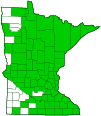cypress spurge
(Euphorbia cyparissias)
Conservation • Weed • Description • Habitat • Ecology • Use • Distribution • Taxonomy
Description |
Cypress spurge is an exotic, weedy, herbaceous plant. It is native to Europe and western Asia. It was introduced into the United States in the 1860s as an ornamental ground cover plant. It readily escapes cultivation, and it is now naturalized in North America. Once established, it is difficult to eradicate. It now occurs throughout the United States and southern Canada. It is especially common in the northeast and upper Midwest. In the west, it occurs mostly around major metropolitan areas. Cypress spurge is an erect, perennial forb that rises from stout, fleshy roots and creeping, horizontal, underground stems (rhizomes). It can be 8″ to 32″ tall, but in Minnesota it is rarely more than 16″ in height. It often forms colonies. The stems are erect or ascending, densely leafy, round, light green, and hairless. It is usually unbranched below the inflorescence at first, but produces several densely-leafy side branches above the middle after flowering time. The stem and leaves exude a sticky white latex when broken. Stem leaves are alternate, crowded, and stalkless. The leaf blades are linear, ⅜″ to 1 3 ⁄16″ long, and 1 ⁄32″ to ⅛″ wide. They are rounded at the base, short-tapered or angled to a sharp point at the tip, and have a single prominent midvein. The upper and lower surfaces are hairless and green, yellowish-green, or bluish-green. The margins are untoothed. At the top of the stem, just below the inflorescence there is a whorl of 10 or more leaves that are similar to stem leaves. What appear to be flowers are actually false flowers (cyathia) common to the Euphorbiaceae (spurge) family. The inflorescence is an umbrella-shaped arrangement (umbel) of 10 to 18 cyathia at the end of the stem. The umbel has 10 or more primary, hairless, pale green branches (rays). At the tip of each ray there is a pair of inflorescence leaves. These leaves are broadly egg-shaped to heart-shaped or kidney-shaped, about ½″ in diameter, rounded or heart-shaped at the base, and broadly angled to short point at the tip. They are greenish-yellow or yellowish-green, becoming somewhat reddish-tinged as they mature. The rays are usually branched above the inflorescence leaves. Each ray or ray branch ends in a singe cyathium. Each cyathium is closely subtended by a pair of showy, bract-like structures (cyathophylls). The cyathophylls are about ¼″ in diameter and otherwise similar to the inflorescence leaves. They are greenish-yellow and cupped around the cyathium at first, turning reddish and flattening out as they mature. They appear superficially like petals. The cyathium is about ⅛″ in diameter on a stalk up to ¾″ long. It consists of an involucre, 4 glands, a single female (pistillate) flower and 15 to 25 male (staminate) flowers. There are no petals or sepals. The involucre is formed from 2 fused bracts and is deeply cup-shaped. The glands are greenish-yellow to yellow, spreading, and crescent-shaped, with a short, outward-curved, hornlike tip at each end. The female flower has 3 styles that are fused at the base for about ⅓ of their length, then split at the tip for about ⅓ of their length into 2 club-shaped lobes. The stamens are crowded around the base of the pistil. Only a few cyathia produce fruit. The fruit is formed from a compound, 3-chambered ovary. It looks like a capsule but is actually schizocarp. It is 3-lobed, 1 ⁄16″ to ⅛″ long, and hairless, and has a pebbled or warty surface. Each schizocarp contains 1 to 3 grayish, 1 ⁄16″ to 3 ⁄16″long seeds. |
Height |
8″ to 16″ |
Flower Color |
Greenish-yellow |
Similar Species |
Leafy spurge (Euphorbia virgata) is similar but a much larger plant, up to 28″ in height. The leaves are larger, up to 4″ long and up to ⅜″ wide, and are not crowded. |
Habitat |
Moderately moist to dry. Open woodlands and disturbed areas, including pastures, vacant lots, roadsides, railroads, and graveyards. Full sun to light shade. Sandy or loamy soil. |
Ecology |
Flowering |
May to August |
Pests and Diseases |
|
Toxicity |
The latex exuded by broken stems and leaves of cypress spurge causes a rash in some people similar to that of poison ivy. The plant may also be toxic to cattle and horses. |
Use |
|
Distribution |
||
|
Sources |
|
| 7/11/2024 | ||
Nativity |
||
Native to Europe and western Asia. Cultivated as an ornamental, escaped cultivation, naturalized in North America. |
||
Occurrence |
||
|
||
Taxonomy |
|
| Kingdom | Plantae (green algae and land plants) |
| Subkingdom | Viridiplantae (green plants) |
| Infrakingdom | Streptophyta (land plants and green algae) |
| Superdivision | Embryophyta (land plants) |
| Division | Tracheophyta (vascular plants) |
| Subdivision | Spermatophytina (seed plants) |
| Class | Magnoliopsida (flowering plants) |
| Superorder | Rosanae |
Order |
Malpighiales (nances, willows, and allies) |
Family |
Euphorbiaceae (spurge) |
| Subfamily | Euphorbioideae |
| Tribe | Euphorbieae |
| Subtribe | Euphorbiinae |
Genus |
Euphorbia (spurges) |
| Subgenus | Esula |
| Section | Esula |
Subordinate Taxa |
|
|
|
Synonyms |
|
Galarhoeus cyparissias Tithymalus cyparissias |
|
Common Names |
|
cypress spurge graveyard spurge |
|
Glossary
Bract
Modified leaf at the base of a flower stalk, flower cluster, or inflorescence.
Cyathium
The false flower of the spurge (Euphorbiaceae) family, consisting of a cup-like involucre surrounding a cluster of small flowers.
Involucre
A whorl of bracts beneath or surrounding a flower, flower head, or flower cluster.
Latex
A milky, clear, or sometimes colored sap that coagulates on exposure to air.
Linear
Long, straight, and narrow, with more or less parallel sides, like a blade of grass.
Ray
In the Asteraceae (aster) family: a strap-shaped flower, or the strap-shaped portion of a flower. In the Apiaceae (carrot) and Euphorbiaceae (spurge) families: a branch of an umbel.
Rhizome
A horizontal, usually underground stem. It serves as a reproductive structure, producing roots below and shoots above at the nodes.
Schizocarp
A dry fruit formed from a compound ovary that splits into two or more parts (mericarps) at maturity.
Umbel
A flat-topped or convex, umbrella-shaped cluster of flowers or buds arising from more or less a single point.
Visitor Photos |
||
Share your photo of this plant. |
||
This button not working for you? |
||
Amanda |
||
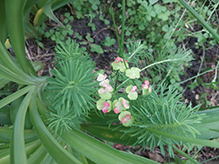 |
|
|
MinnesotaSeasons.com Photos |
||
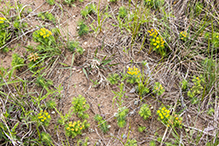 |
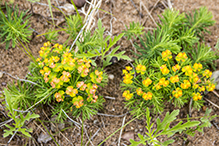 |
|
| Colony | Plants | |
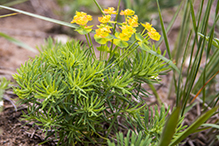 |
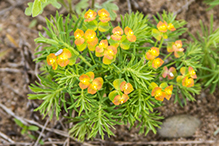 |
|
Plant |
Inflorescence |

Slideshows |
|

Visitor Videos |
||
Share your video of this plant. |
||
This button not working for you? |
||
|
Other Videos |
||
Cypress Spurge |
About
Uploaded on Jun 18, 2010 Cypress spurge is an invasive plant in Presque Isle State Park. Learn a little bit about this plant and why it's dangerous. This is just one of the nature walks that took place at the 2010 PA Wild Resource Festival at the Tom Ridge Center in Erie, PA. |
Cypress Spurge (Euphorbia Cyparissias) - 2012-05-30 |
About
Published on Jun 1, 2012 Euphorbia cyparissias, the Cypress Spurge, is a plant in the genus Euphorbia. --------------------- 52.03999 4.23574 |
Laptele cucului -Euphorbia cyparissias |
About
Published on Apr 11, 2014 |
Euphorbia cyparissias - Zypressen-Wolfsmilch, Cypress Spurge |
About
Published on Apr 26, 2014 Die Zypressen-Wolfmilch (Euphorbia cyparissias) und tierische Nebendarsteller wie Maikäfer, Fliegen, Schmetterlinge. Cypress Spurge (Euphorbia cyparissias) with butterflies, flies and cockchafer. |

|
Created: Last Updated: © MinnesotaSeasons.com. All rights reserved. |
